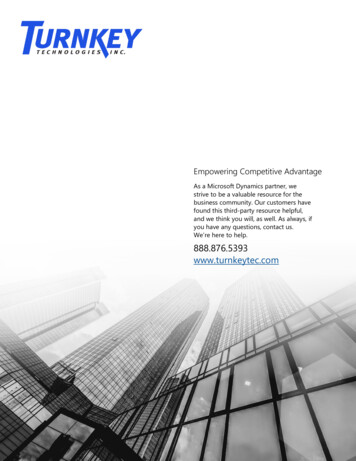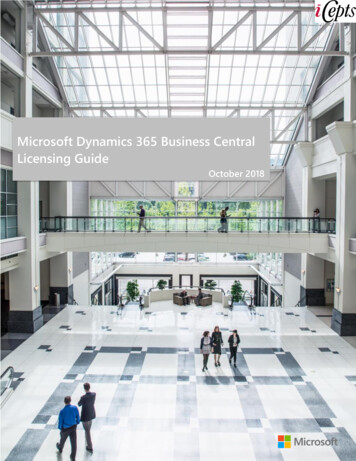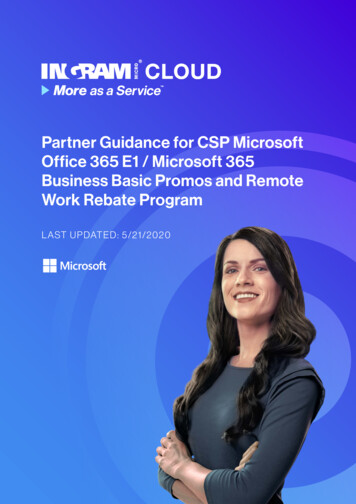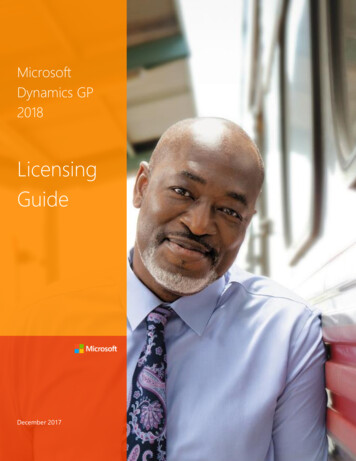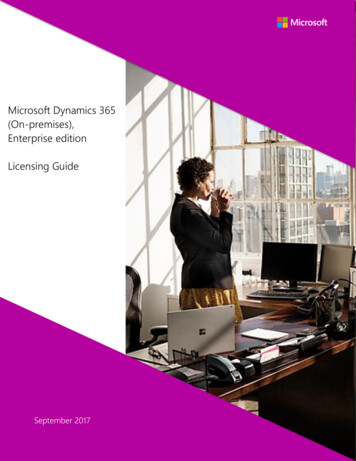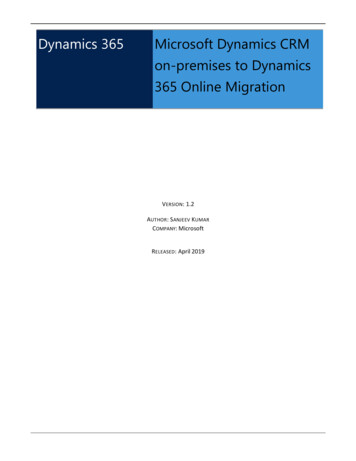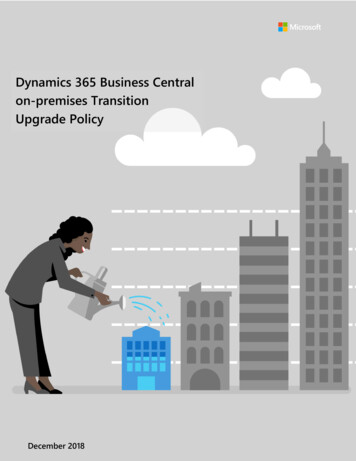
Transcription
Dynamics 365 Business Centralon-premises TransitionUpgrade PolicyMicrosoft Dynamics Perpetual Licensing Transition Upgrade Policy December 2017December 2018
ContentsDynamics 365 Business Central on-premises Transition Upgrade Policy . 1License Migration Transition Upgrade (LMT Upgrade). 2Creation of New User Types for LMT Upgrades . 3Transition Upgrade of Microsoft SQL Server Runtime Licenses purchased from the Dynamics Price List . 3Additional Policies . 4Downgrade Policy . 4LMT Upgrade Protected List Price (PLP) Policy . 4Country Localization Policy . 4APPENDIX A: LMT Upgrade License Conversion Table . 5Change Log . 7Microsoft Dynamics Perpetual Licensing Transition Upgrade Policy December 2018
OverviewPerpetual Licensing provides a step forward by simplifying how customers purchase their ERP solution.With Dynamics 365 Business Central on-premises, you must license at least one of Dynamics 365 BusinessCentral Essentials or Dynamics 365 Business Central Premium users. Additional access to the servicefunctionality by other users is licensed with Dynamics 365 Business Central Team Members.For partners, this model should allow an accelerated sales cycle as quick and accurate price quotes can beeasily calculated without having to go through a complex scoping exercise.For more information on the new licensing model, please refer to the licensing guide available at theDynamics 365 Business Central on-premises/Dynamics NAV pricing page on PartnerSource.This transition upgrade policy document describes the transition upgrade path for customers wanting toupgrade from Microsoft Dynamics NAV 2018 (or prior version) or from Microsoft Dynamics NAV 2009 (orprior version) to Microsoft Dynamics 365 Business Central on-premises, along with additional policies thatmay affect customer upgrades including but not limited to the Downgrade Policy and the EnhancementPlan Policy.Transitions to Dynamics 365 Business Central on-premises across product lines are not addressed in thispolicy as they are subject to the Microsoft Dynamics Licensing Transition Policy. Cross-product transitionsinclude transitions from Microsoft Dynamics 365 for Operations on-premises, Microsoft Dynamics GP,Microsoft Dynamics AX, or Microsoft Dynamics SL to Microsoft Dynamics 365 Business Central onpremises.Dynamics 365 Business Central on-premises Transition UpgradePolicyThe Perpetual Licensing model is incompatible with previous versions of the products. Consequently,Dynamics 365 Business Central on-premises is not available on either the Business Ready Licensing (BRL)or the Module Based Licensing (MBL) models and upgrades to Dynamics 365 Business Central onpremises require a bridging of license models.Microsoft Dynamics 365 Business Central on-premises Upgrade Policy December 2018Page 1
Microsoft wants to encourage customers to benefit from the latest innovations in the product. DynamicsNAV customers with an active Dynamics Enhancement Plan will be able to upgrade to Dynamics 365Business Central on-premises via the License Migration Transition Upgrade (LMT Upgrade) path.License Migration Transition Upgrade (LMT Upgrade)The LMT Upgrade path is available to Dynamics NAV customers with an active Enhancement plan. Withthe LMT Upgrade, Dynamics NAV MBL, BRL and Perpetual customers are mapped to Dynamics 365Business Central on-premises to ensure that customers receive at least their current functionality plus thenumber of users they have already licensed except as noted below*.The LMT Upgrade path is available to customers as of the General Availability (GA) of Dynamics 365Business Central on-premises. However, customers need to meet the eligibility criteria for the LMTUpgrade path.*Important note: Customers running a functionality discontinued by Microsoft in any version prior to and includingDynamics 365 Business Central on-premises are informed that an upgrade will result in a loss of such functionalitywhich will be unavailable through the Dynamics 365 Business Central on-premises key. The sole functionalities thatare licensable with Dynamics 365 Business Central on-premises will be available after the upgrade is processed.Microsoft also expressly declines any responsibility regarding the upgrade compatibility of a functionality offered byan Independent Software Vendor.License Migration Transition Upgrade (LMT Upgrade)EligibilityThe LMT Upgrade path is available to all Dynamics NAV MBL, BRL and Perpetual customers who have anactive Enhancement plan. The LMT Upgrade will apply to these customers regardless of when they chooseto upgrade.Important note: The LMT Upgrade must be ordered through Order Central.MigrationA set of LMT Upgrade rules map which Dynamics 365 Business Central on-premises functionality packsand the quantity and type of users customers will receive in exchange for their configuration prior to theLMT Upgrade.See Appendix A for details about the rules.By choosing to upgrade, the customer acknowledges that there could be material changes impacting theuse of functionality and users deployed in the ERP Solution prior to the LMT Upgrade.Customer Service PolicyCustomers are required to be on Enhancement when the LMT Upgrade order is placed. The EnhancementPlan expiration date and the Protected List Price of the configuration prior to the LMT Upgrade will becarried over to the Dynamics 365 Business Central on-premises configuration. The Enhancement Plan willnot recalculate Protected List Price (PLP) when performing an LMT Upgrade to Dynamics 365 BusinessCentral on-premises. Customer will continue to use their existing PLP until the Enhancement Plan expiresor is re-calculated due to any other circumstance described in the then-current Dynamics policies.Microsoft Dynamics 365 Business Central on-premises Upgrade Policy December 2018Page 2
Use of Old Version after Transition Upgrade To New VersionOnce the new version goes into a production environment (e.g. process business operations or create newtransactions), customers may only access the transitioned (old) version to reference past transactions fortax, audit, and/or reporting purposes. However, as soon as the license key for the new product version isissued, customers will not be able to add users and/or modules directly to the transitioned version(s).Creation of New User Types for LMT UpgradesLimited Upgrade users and devicesThe ‘Full Concurrent User CAL - Limited Upgrade’, ‘BRL Advanced Management Users - Limited Upgrade’,‘BRL Business Essentials Users - Limited Upgrade’, ‘Additional Professional Users - Limited Upgrade’, ‘LightUser – Limited Upgrade’, ‘Employee Self Service User – Limited Upgrade’, ‘Limited Device CAL – LimitedUpgrade’, ‘Limited Concurrent CAL – Limited Upgrade’ and ‘Web User – Limited Upgrade’ have the samelicensing rights as their counterparts not designated as ‘Limited Upgrade’ but have different LMT Upgrademapping rules than as indicated in Appendix A.Dynamics NAV 2009 and Dynamics NAV 2018 customers transitioning to Dynamics 365 Business Centralon-premises will receive two Business Central on-premises Full Named users for each NAV Concurrent Fulluser licensed prior to October 1, 2018.Dynamics NAV 2009 and Dynamics NAV 2018 customers transitioning to Dynamics 365 Business Centralon-premises will receive one Business Central on-premises Full Named user for each NAV Concurrent Fulluser licensed after October 1, 2018.Dynamics NAV 2018 customers transitioning to Dynamics 365 Business Central on-premises will receivetwo Business Central on-premises Team Members licenses for each Limited Concurrent CAL licensed priorto December 1, 2018.Dynamics NAV 2018 customers transitioning to Dynamics 365 Business Central on-premises will receiveone Business Central on-premises Team Members licenses for each Limited Concurrent CAL – LimitedUpgrade licensed after December 1, 2018.Full User – UpgradeThe ‘Dyn365 Business Central Essentials – Upgrade’, ‘Dyn365 Business Team Members – Upgrade’ and‘Dyn365 Business Central Premium – Upgrade’ users are used by the system for LMT Upgrades and carrythe exact same licensing rights as their counterparts designated without the ‘Upgrade’ suffix. These usershave a System List Price of 0 and have a Protected List Price of 0. These user types are not available forpurchase. Please see Appendix A for more information.Transition Upgrade of Microsoft SQL Server Runtime Licenses purchasedfrom the Dynamics Price ListMicrosoft SQL Server Runtime licenses are not available on the Dynamics 365 Business Central onpremises price list. Dynamics 365 Business Central on-premises customers may acquire Microsoft SQLServer licenses through a Volume Licensing partner of their choosing.Microsoft Dynamics 365 Business Central on-premises Upgrade Policy December 2018Page 3
The Microsoft SQL Server Runtime licenses of Dynamics NAV 2018 and Dynamics NAV 2009 customerswill be made available for those customers on the Dynamics 365 Business Central on-premises licenseafter the Transition Upgrade. However, these customers cannot license additional Microsoft SQL Runtimelicenses from the Dynamics 365 Business Central on-premises price list. Dynamics 365 Business Centralon-premises customers who require additional Microsoft SQL Server licenses can license these throughVolume Licensing.Additional PoliciesDowngrade PolicyDynamics 365 Business Central on-premises customers cannot downgrade to Dynamics NAV 2018, or anyprior version of Dynamics NAV.Existing eligible customers performing a Transition Upgrade need to understand that they will not be ableto retrograde to a prior version after the Transition Upgrade is processed.LMT Upgrade Protected List Price (PLP) PolicyCustomers doing an LMT Upgrade to Dynamics 365 Business Central on-premises are restricted fromreducing the value of their PLP for thirty-six-months prior to the LMT Upgrade. This policy takes effectOctober 1, 2018. PLP reductions predating the effective date are exempt from this policy.Before being allowed to do an LMT Upgrade, customers with reduced PLPs must repurchase anycombination of users and functionality to reestablish the highest PLP in effect within 36 months of theLMT Upgrade request (but no earlier than starting July 11, 2012).The PLP from the upgrading product version will be allocated to the Dynamics 365 Business Central onpremises configuration according to the LMT Upgrade mapping rule. See Appendix A for details about therules.Country Localization PolicyMicrosoft Localized VersionsCustomers may license any country-specific localized version. However, if a customer deploys a countryspecific localized version that is not developed by Microsoft specifically for their country, either becausethe localized version for their country is not yet available or because the customer chooses the localizedversion designed for another country, the customer will be first required to execute a Microsoft CustomerAcknowledgement Authorization (MCAA).Partner Localized versionsPartners are required to execute a Microsoft Dynamics Partner Localization and Translation LicensingProgram (PLLP) for country-specific localizations developed by partners.Transitioning from Microsoft Localization to Partner LocalizationCustomers in countries moving from Microsoft localized versions to partner localized versions willupgrade to the W1 version of Dynamics NAV 2018 and partners will need to complete a PLLP if thecustomer chooses to deploy the partner localized version.Microsoft Dynamics 365 Business Central on-premises Upgrade Policy December 2018Page 4
APPENDIX A: LMT Upgrade License Conversion TableDynamics NAV to Dynamics 365 Business Central on-premisesFrom LicenseModelEditionUser/FunctionalityBasic General LedgerPer Additional Users or Web UsersMBLAnyPer Additional Users - LimitedUpgradeFor every 3 Web Users – LimitedUpgradeOther MBL modulesAM Foundation Pack1 Premium User 1 PremiumUser - Upgrade1 Premium User 1 PremiumUser - UpgradePLP Allocated toPremium UsersPremium Users1 Premium UserPremium Users1 Team MemberTeam MemberIncluded in Essentials orPremium User1 Premium User 1 PremiumUser - UpgradeEssentials or Premium UserPremium UsersPer Additional AdvancedManagement User or Light User1 Premium User 1 PremiumUser - UpgradePremium UsersPer Additional AdvancedManagement User - LimitedUpgrade1 Premium UserPremium UsersBE Foundation Pack1 Essentials User 1 EssentialsUser - UpgradeEssentials UsersBusinessEssentialsPer Additional Business EssentialUser or Light User1 Essentials User 1 EssentialsUser - UpgradeEssentials Users1 Essentials UserEssentials Users1 Team MemberTeam MemberAnyPer Additional Business EssentialUser - Limited UpgradeEach ESS User or Limited DeviceCALPer 3 Light User – LimitedUpgrade1 Team MemberTeam MemberPer 6 ESS User – Limited Upgrade1 Team MemberTeam MemberPer 3 Limited Device CAL –Limited Upgrade1 Team MemberTeam MemberStarter Pack3 Premium User 3 PremiumUser - UpgradePremium UsersPer Full Concurrent CAL or FullConcurrent CAL - Upgrade1 Premium User 1 PremiumUser - UpgradePremium UsersPer Full Concurrent CAL - LimitedUpgrade1 Premium UserPremium UsersExtended PackIncluded in Premium UserPremium UserStarter Pack3 Essentials User 3 EssentialUser - UpgradeEssentials UsersPer Full Concurrent CAL1 Essentials User 1 EssentialUser - UpgradeEssentials UsersPer Full Concurrent CAL - LimitedUpgrade1 Essentials UserEssentials UsersAdvancedManagementBRLBC Functionality MappingwithExtendedPackPerpetualno ExtendedPackMicrosoft Dynamics 365 Business Central on-premises Upgrade Policy December 2018Page 5
EditionAnyAnyAnyUser/FunctionalityBC Functionality MappingPLP Allocated toPer Limited Concurrent CAL1 Team Member 1 TeamMember - UpgradeTeam MemberPer Limited Concurrent CAL –Limited Upgrade1 Team MemberTeam MemberApplication BuilderApplication BuilderApplication BuilderSolution DeveloperSolution DeveloperSolution unitsXML PortsXML PortsXML iesMicrosoft SQL Server 2008 R2Enterprise Edition Runtime Use orServers and CALsMicrosoft SQL Server 2012Standard Edition Runtime UseServers and CALsMicrosoft SQL Server 2017Enterprise Edition Runtime UseServers and CALsMicrosoft SQL Server 2017Standard Edition Runtime UseServers and CALsMicrosoft SQL Server 2017Enterprise Edition Runtime UseServers and CALsMicrosoft SQL Server 2017Standard Edition Runtime UseServers and CALsMicrosoft SQL Server 2017Enterprise Edition Runtime UseServers and CALsMicrosoft SQL Server 2017Standard Edition Runtime UseServers and CALsMicrosoft SQL Server 2017Enterprise Edition RuntimeUse Servers and CALsMicrosoft SQL Server 2017Standard Edition RuntimeUse Servers and CALsMicrosoft SQL Server 2017Enterprise Edition RuntimeUse Servers and CALsMicrosoft SQL Server 2017Standard Edition RuntimeUse Servers and CALsMicrosoft Dynamics 365 Business Central on-premises Upgrade Policy December 2018Page 6
Change hangeActionDateNew Team Member – Upgrade has been introduced. The‘Dynamics NAV to Dynamics 365 Business Central onpremises’ conversion table has been updated with reference tothe ‘Team Member – Upgrade SKU.December 2018NewAdditional guidance has been added regarding the mappingof Full Concurrent users and Limited Concurrent CALs toBusiness Central on-premisesDecember 2018 2018 Microsoft Corporation. All rights reserved.This document is for informational purposes only. MICROSOFT MAKES NO WARRANTIES, EXPRESS OR IMPLIED, IN THIS DOCUMENT. This informationis provided to help guide your authorized use of products you license; it is not your agreement. Your use of products licensed under your licenseagreement is governed by the terms and conditions of that agreement. In the case of any conflict between this information and your agreement, theterms and conditions of your agreement control. Prices for licenses acquired through Microsoft resellers are determined by the reseller .Microsoft Dynamics 365 Business Central on-premises Upgrade Policy December 2018Page 7
Dynamics 365 Business Central on-premises/Dynamics NAV pricing page on PartnerSource. This transition upgrade policy document describes the transition upgrade path for customers wanting to upgrade from Microsoft Dynamics NAV 2018 (or prior version) or from Microsoft Dynamics NAV 2009 (or



